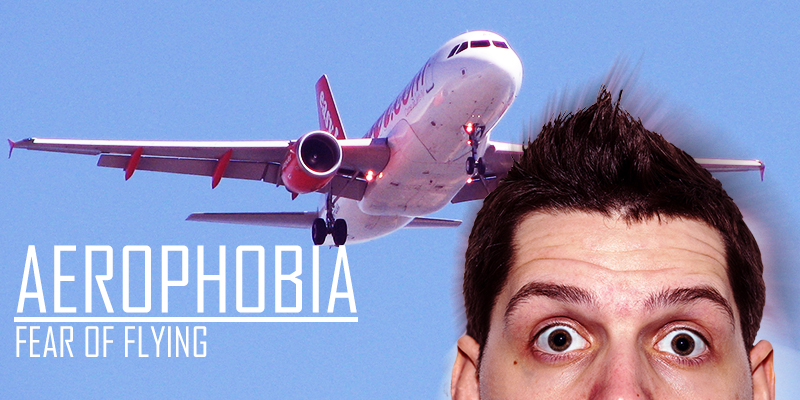Air travel has become an inseparable part of people’s life in this modern era. However, it may not be fascinating to roam in air, among the clouds for everyone. The intense fear and nervousness of flying is known as aerophobia. Aerophobia, also known as aviophobia or flight phobia, is signified by extreme fear and anxiety to travel by air in airplanes, helicopters, parachutes or other air transports. This kind of fear can take a serious lead if it starts affecting the normal living where one needs to make frequent air travels. The phobia can be developed alongside other phobias like Acrophobia (fear of heights) and Claustrophobia (fear of enclosed spaces).

How Common Is Aerophobia?
Studies show that at least one in five people have aerophobia. Among the air travelers, approximately 25 percent were seen to have aerophobia. This is one of the most common phobias occurring to people. It can occur with anyone regardless of age, sex or any other personal attributes. Even famous celebrities like Ronald Reagan and Sandra Bullock have admitted to have been fearful of flying.
What Causes Aerophobia?
Different kinds of factors can develop aerophobia in a person.
A Traumatic Experience
Many times, the phobia of flight and air travel is developed by experiencing a similar trauma related with air travel such as air crash, or hijacking. Several other times, the fear can be a result of watching extensive coverage of air crash, hijacking and related news on TV and internet. A person might also develop this kind of phobia upon witnessing or hearing someone else going through a hurtful event in air travel.
Other Phobias
Many other phobias can also trigger aerophobia in people. It is closely associated with Claustrophobia (fear of enclosed and confined places) and Acrophobia (fear of heights). Sometimes, people having Social phobia (fear of social situations) and Agoraphobia (fear of panicking in public place) may also develop aerophobia when they might need to do air travel. Similarly, many people might have motion sickness and have vertigo (fear of dizziness) during flight. This can also consequently develop aerophobia.
Inheritance
People are more vulnerable to develop aerophobia is he/she has any family history of aerophobia. It is a natural instinct they inherited and learnt it from their family.
Different Medical Conditions
Several medical conditions such as sinus problems, flu, ear ailments and deep vein thrombosis are also known to have developed aerophobia in patients.
What Are The Symptoms of Aerophobia?
Some people may suffer from mild anxiety before any air travel and some may be suffering from a severe form of aerophobia. Common symptoms occurring in people having aerophobia are:
- Intense and constant fear along with distressful thoughts about flying (before and during any kind of air travel)
- Visible discomfort while waiting for flight in airport or while boarding the flight
- Complete avoidance of air travels and even related places like airports in severe cases
- Confusion and being unable to think clearly when suffering from anxiety
- Aggressive combat and getting angry at family, friends and airport staffs
- Panic attacks accompanied by physical ordeals like shaking, nausea and vomiting, abdominal uneasiness, diarrhea, frequent urination, racing heartbeat, chest pain, dizziness and fainting, sweating and clammy hands
When to Visit a Doctor?
If the above symptoms have been occurring for more than six months time, and disrupted your daily living then you need to start the treatment process. Moreover, if you or any of your family members have been avoiding trips, and work affairs due to the fear of flying, you need to consult with a doctor.
How Is Aerophobia Treated?
Many ways are there which can help with controlling the symptoms of aerophobia such as
Exposure therapy
The therapist would explore through the fear induced in a person by exposing the person to a real or imitated flight. The person is guided through different relaxation techniques such as breathing exercises and visualization exercises to confront the fear during the exposure. Through regular sessions along with relaxation exercises, the level of fear is reduced gradually.
Cognitive Behavioral Therapy (CBT)
CBT goes hand in hand with exposure therapy. The therapist aims to recognize the negative thoughts circling the person’s mind associated with air travel. Through intensive talking and sharing process, the therapist tries to instill positive thoughts and behavior in the person. The major goal is to help the person regain a suitable behavior for air travel.
Flight courses
There are special kinds of flight courses available for people prior having air travels where the flight personnel and psychologist briefs about aviation and relaxation techniques to use during the travel.
Medications
In severe cases, medicines such as anti-anxiety and anti-depressant drugs are prescribed by the doctor to keep the symptoms of anxiety in control.